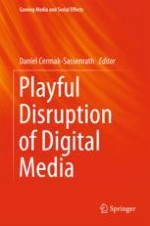2018 | OriginalPaper | Buchkapitel
Makin’ Cake—Provocation, Self-confrontation, and the Opacity of Play
verfasst von : Daniel Cermak-Sassenrath
Erschienen in: Playful Disruption of Digital Media
Verlag: Springer Singapore
Aktivieren Sie unsere intelligente Suche, um passende Fachinhalte oder Patente zu finden.
Wählen Sie Textabschnitte aus um mit Künstlicher Intelligenz passenden Patente zu finden. powered by
Markieren Sie Textabschnitte, um KI-gestützt weitere passende Inhalte zu finden. powered by
